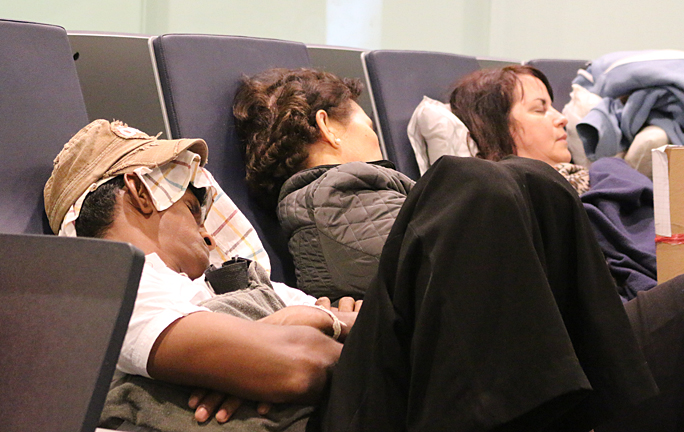The experience of a phenomenon called jet lag can in and of itself wreak havoc on the natural sleeping rhythms of a traveler — 14 tips to fight jet lag are given in this article — but what if the state or country to which a person travels experiences the least amount of sleep in the world as part of its normal sleeping pattern; and how was the sleeping pattern determined?
When and How Does Much of the World Sleep?

To extract geotagged tweets containing #goodmorning and #goodnight hashtags, Twitter API was used. Then — based on the location associated with each tweet — what time each message was posted was determined using the Coordinated Universal Time and time zone corresponding to that location, which was taken from TimeZoneDB.
Wake-up time for each location was estimated as the average local time of tweets containing #goodmorning hashtag posted from that location minus 15 minutes; whereas typical bedtime was calculated as average time of tweets with #goodnight tag posted from a given location plus 15 minutes, based on the assumption that it takes roughly 15 minutes for a person to fall asleep.
Percent of night owls was taken as the percentage of #goodnight tweets posted in a given location after midnight local time.
Data was collected in September 2021.
I have been given express written permission to use the maps and the verbatim text from this article from Mornings.co.uk, which highlights how people sleep in many countries around the world. This information is general in nature only and does not constitute personal advice. While Mornings.co.uk has endeavored to ensure the information provided is accurate and current, it cannot guarantee it. Neither Mornings.co.uk nor The Gate accept liability for the information which is presented in this article.
Sleeping Patterns Around the World: How the World Sleeps
While all humans need 7 to 9 hours of sleep, the quality and quantity of sleep differ from country to country. Sleep patterns can be affected by any number of regional differences — climate, medicine, access to electricity — and have continued to evolve throughout human history. To determine how sleep habits vary around the world, we estimated the average wake-up times and bedtimes of people in over 130 countries using geotagged tweets from Twitter API.
By extracting tweets containing the hashtags #goodmorning and #goodnight, we were able to estimate average wake-up times and bedtimes for Twitter users around the world and determine how long an average night’s sleep is in each country.
Key Findings
- The Middle East and Central Asia get the most sleep of any region, at an estimated 9 hours and 42 minutes.
- North America gets the least sleep of any continent, at an average of 8 hours and 11 minutes.
- Of the nine countries that get at least 11 hours of sleep, five are in Europe — Spain, Austria, Georgia, Portugal and Luxembourg.
- Within the United States, residents of Minneapolis and St. Paul, Minnesota; New Orleans and Baton Rouge, Louisiana; and Burlington, Vermont, get the most sleep. Meanwhile, residents of Detroit, New York, Tampa, Chicago, and Las Vegas sleep the least.
We organised our sleep data by country, city, and state.
India is the Country with the Most Night Owls
While sleeping patterns tend to be similar across neighbouring countries in the same region, the countries getting the most and least sleep on average make a relatively diverse list. Explore our chart below to see the 5 countries with the longest and shortest sleep durations.
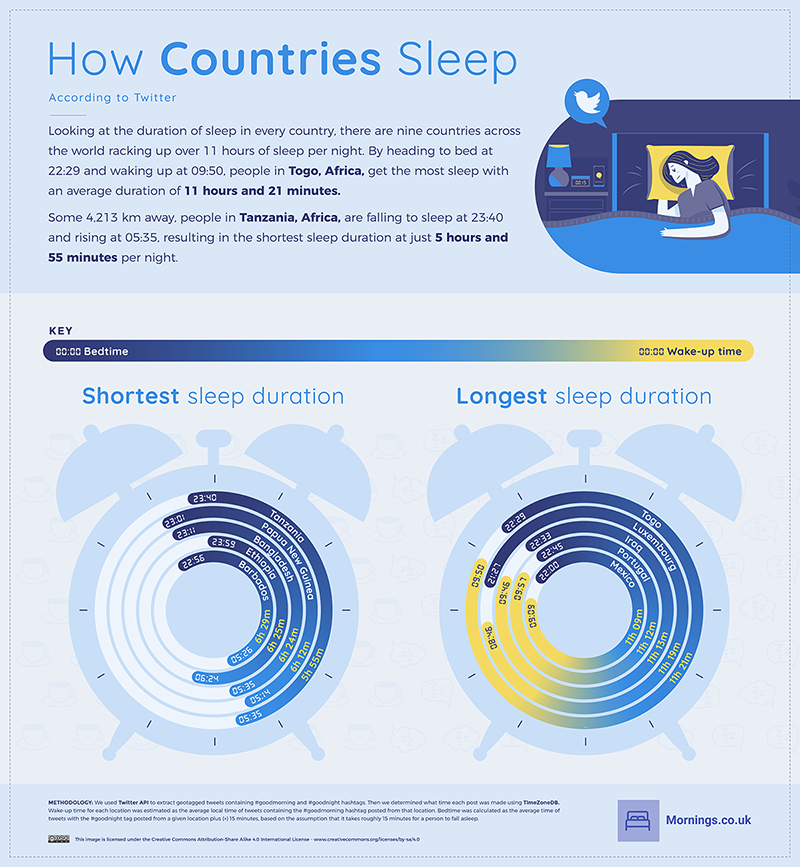
While the relationship between sleep and wealth is complex, the 10 countries getting the least sleep are all relatively poor. The GNI per capita of these countries ranges from $2,300 in Ethiopia to $15,740 in Barbados, each less than the global average of $17,482. The GNI per capita of Luxembourg, the country with the second-longest sleep duration in the world, is $77,350 — the fourth highest of any country.
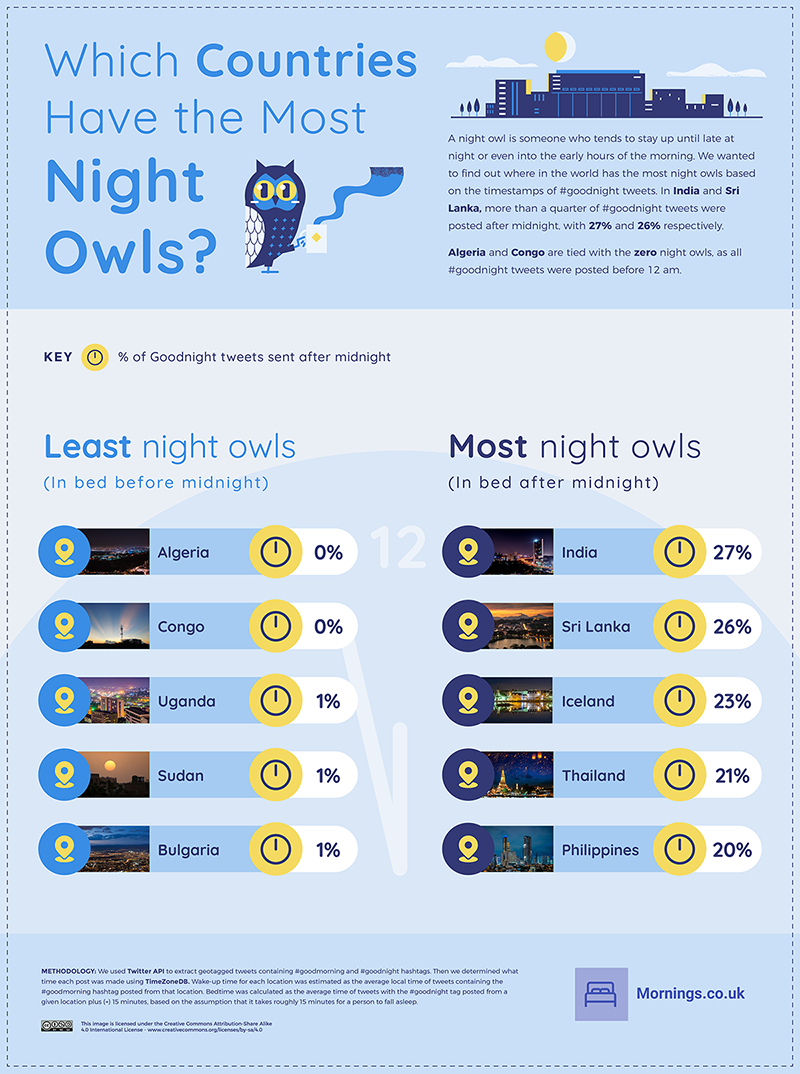
Before the widespread availability of electricity and artificial light allowed people to stay awake late into the night, it was not uncommon for people to go to sleep as soon as the sun went down. There are still many parts of the world without broad access to electricity, which may affect how late people stay awake. While in the 10 countries with the most night owls, at least 96% of the population has access to electricity. According to the World Bank, in four of the 10 countries with the fewest night owls, less than 54% of the population has access to electricity.
Twitter Users of Bangalore Sleep The Longest
The average Twitter user in Bangalore, India, goes to bed at 22:26 and wakes up at 9:29, resulting in a sleep duration of 11 hours and 3 minutes — the longest of any city. Explore our chart below to see which cities sleep the longest and which cities sleep the shortest.
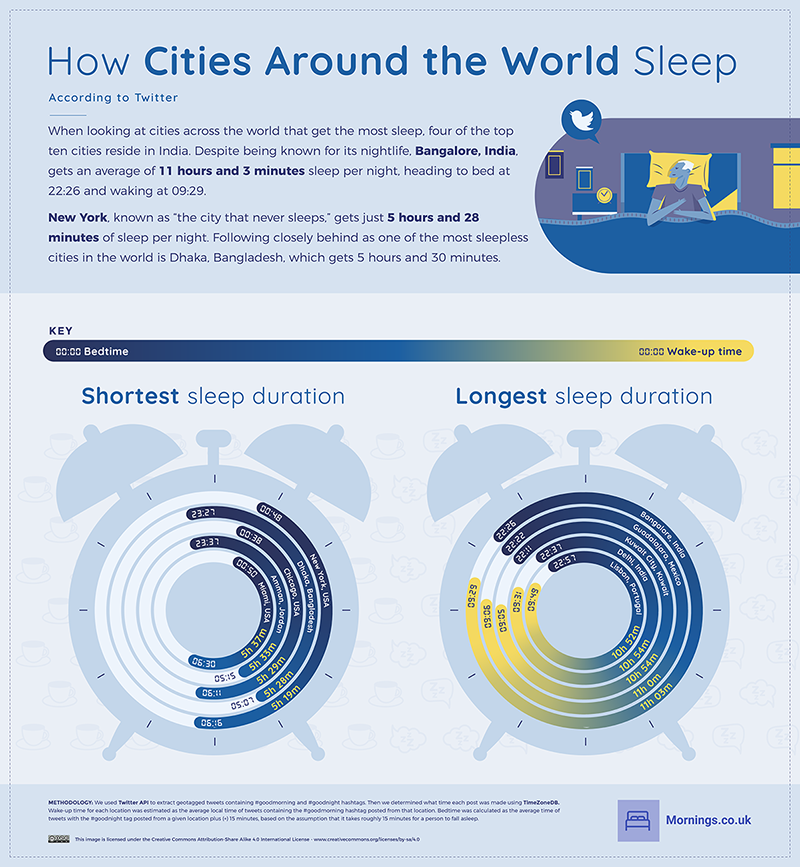
While dense urban areas have more noise, light, and air pollution than smaller cities, our data does not show that more crowded metros get worse sleep. In fact, Bangalore, Guadalajara, Delhi, Monterrey, Mumbai, and Chennai — where Twitter users all get at least 10 and a half hours of shut-eye a night — all rank among the 40 most densely populated cities in the world. Meanwhile, a majority of the cities getting the least sleep are relatively low density and in the United States.
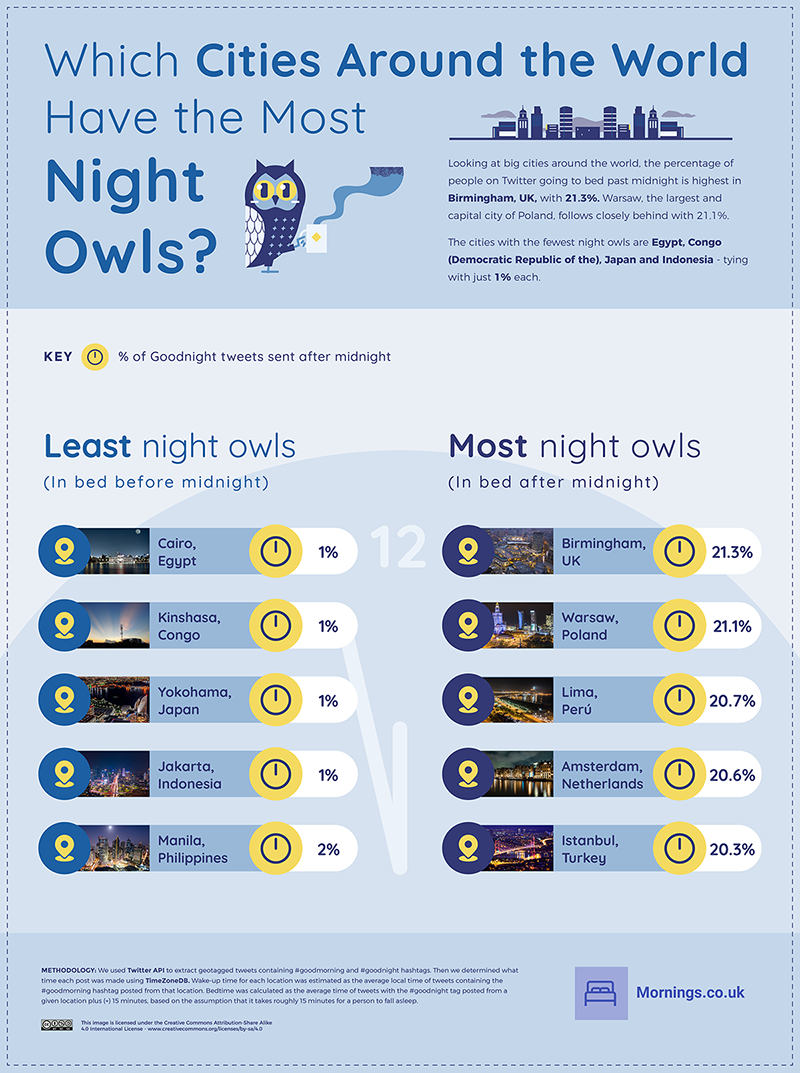
Many of the cities with the most night owls are known for their robust nightlife. Metros like Amsterdam, New York, and Berlin, where roughly one in five tweets hashtagged #goodnight are sent after midnight, appear in almost any list of cities with the best nightlife. Berlin is home to numerous clubs open 24 hours a day, and in 2013 Amsterdam issued its first 24-hour nightlife permit.
Citizens of Minneapolis Sleep for almost 10 Hours Each Night
Twitter users in Minneapolis get an estimated 9 hours and 46 minutes of sleep every night, the most of any U.S. city. Across the Mississippi river, Twitter users in St. Paul get an average of 9 hours and 39 minutes, the second most of any U.S. city.
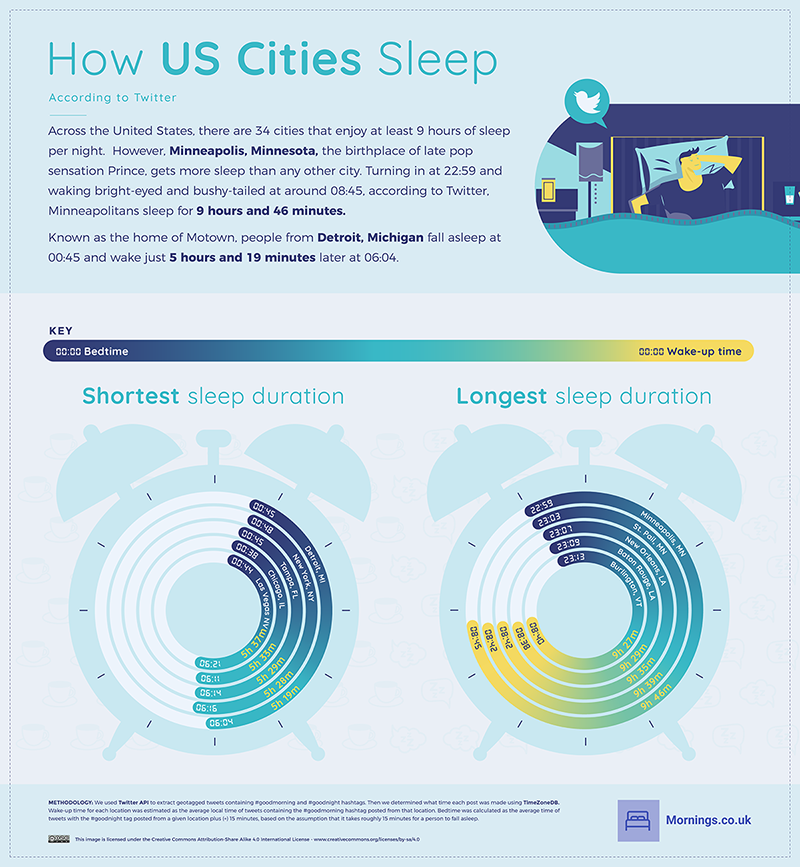
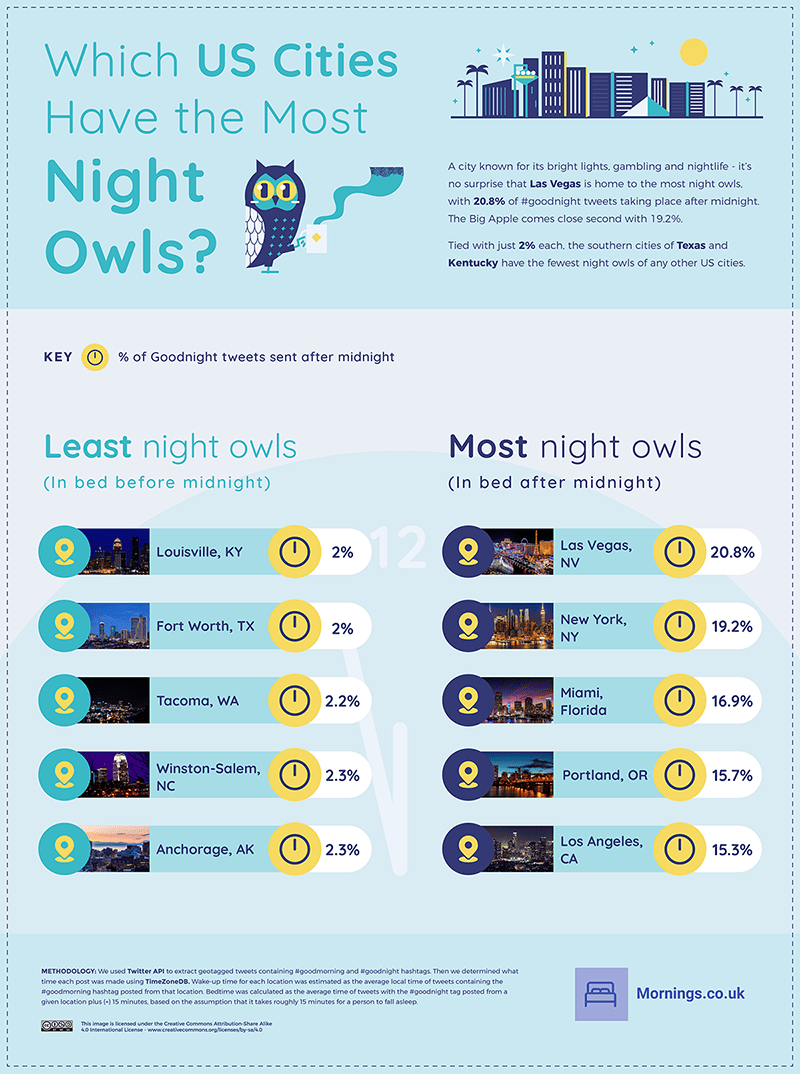
Approximately one in five tweets hashtagged #goodnight is sent after midnight in Las Vegas and New York, the two U.S. cities with the most night owls. Not surprisingly, smaller cities like Fort Worth, Texas; Louisville, Kentucky; and Tacoma, Washington have the smallest share of night owls. While this trend does not hold globally, larger cities in the United States tend to have a larger percentage of night owls.
Michigan is the US State that Gets the Least Sleep
In Michigan, the average Twitter user gets an estimated 5 hours and 56 minutes of sleep a night — the least of any state. Looking at the chart below, we can see how widely sleeping habits vary across the United States.
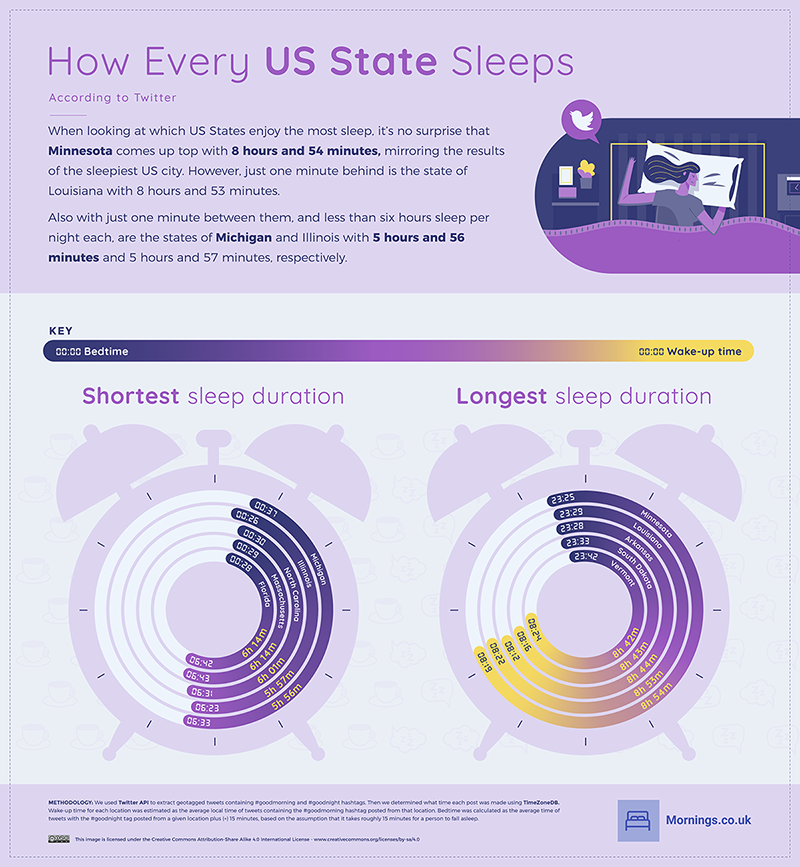
While around the world, denser urban areas do not get more sleep than less crowded cities. In the United States, sleep duration heavily correlates with population density. In 7 of the 10 states with the most sleep, the population density is less than the national average of 93.8 people per square mile. In all 10 states with the least sleep, the population density is greater than the national average.
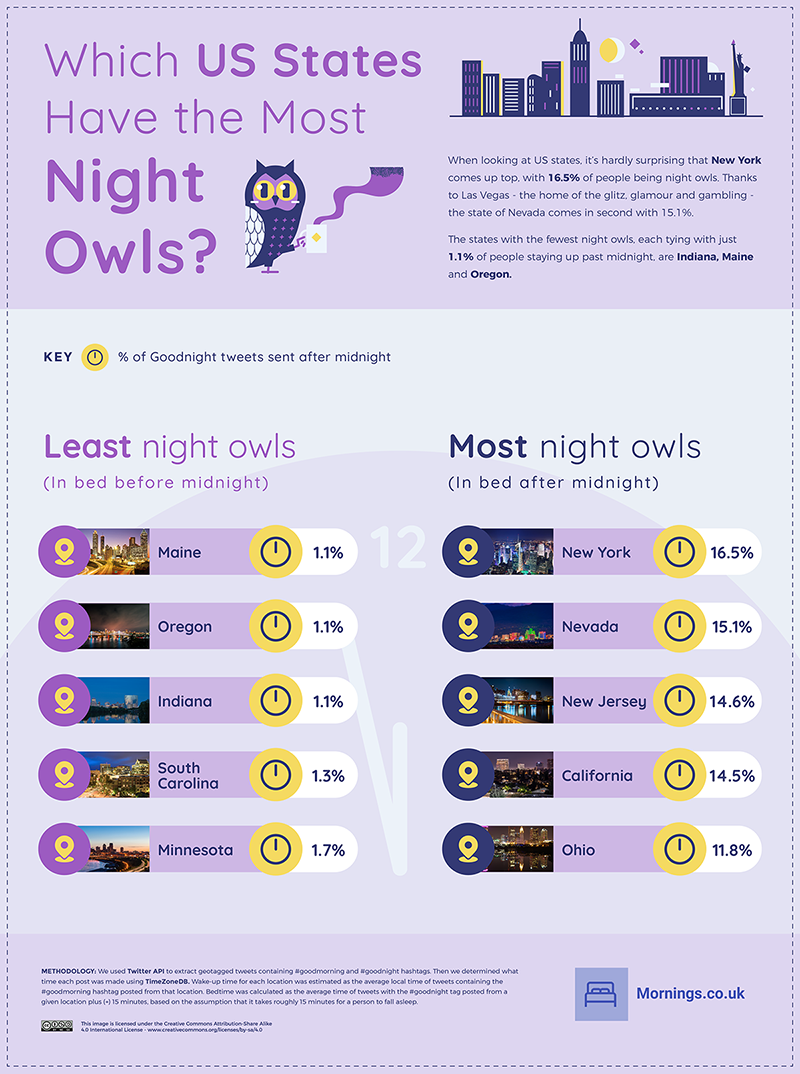
The states with the most night owls are home to large cities with extensive nightlife. In New York state, 16.5% of all tweets hashtagged #goodnight are sent after midnight, the most of any state. Many of those are likely coming from New York City, where 19.2% of #goodnight tweets are sent past midnight. Similarly, 15.1% of all users tweeting the #goodnight hashtag in Nevada do so after midnight, the second-largest share of any state. In Las Vegas, 20.8% of all #goodnight hashtags go out after midnight, the most of any U.S. city.
Rest in the Rest of the World
Numerous factors affect how people sleep. Unique customs around the world — afternoon siestas in Spain, office naps in Japan, outdoor naps for babies in Scandinavia, and polyphasic sleep in Egypt, for example — likely impact when people go to sleep and for how long.
To learn more about how the world sleeps, click through our table below, containing sleep data for over 130 countries. You can explore data on bedtime, wake-up time, sleep duration, and night owls by country, city, and state.
Final Boarding Call
Interestingly, I find that even though I am typically a staunch “night owl” — I have been known to stay up until 6:30 in the morning at times — I historically am a morning person when traveling. I will explain the reasons why in a future article.
Having been born and raised in New York, I am not surprised at all that people in that city have the shortest duration of sleep, as there is not only so much to see and do in New York, but people are under a lot of stress there as well. Perhaps that is the main reason why I could sleep for as few as three hours at times and still be able to get in a full day the next day.
What are your experiences with the sleep patterns of the cities and countries which you have visited during your travels? Please post them in the Comments section below.
All photographs ©2015 and ©2019 by Brian Cohen.
